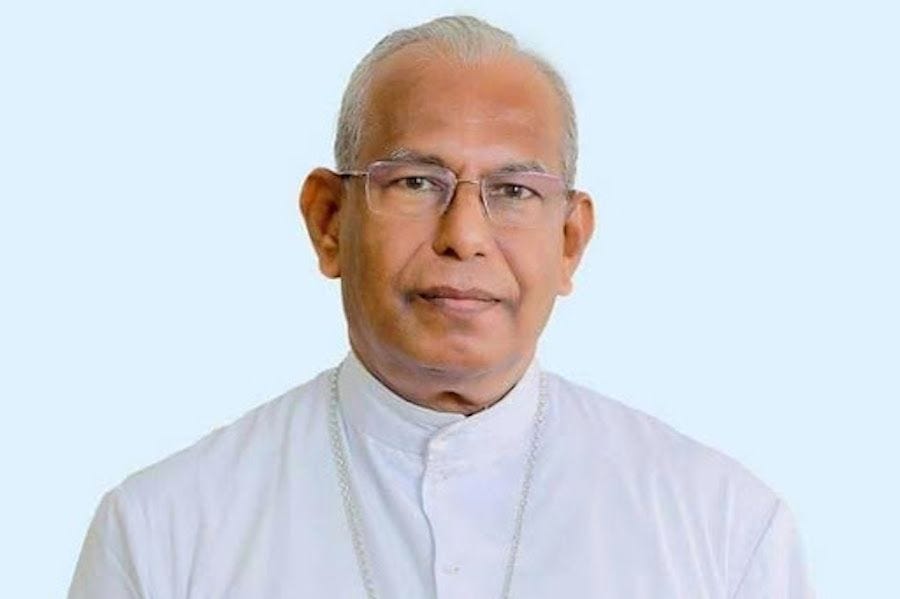
A judge has granted an Indian archbishop’s request to see police clear protestors outside his residence, amid a supercharged liturgical dispute in the Syro-Malabar Catholic Church. Police will also provide the archbishop with an escort when needed, the judge decided.
Kerala High Court judge Anu Sivaraman approved on Dec. 5 a petition by Archbishop Andrews Thazhath, who was named apostolic administrator of the Archeparchy of Ernakulam-Angamaly by Pope Francis on July 30.
Start your day with Starting Seven - a daily news roundup in your inbox.
The judge accepted the archbishop’s request for police help “for the smooth ingress and egress to the Major Archbishop’s House” in Ernakulam, southern India, as well as the removal of protesters gathered at the building in protest at the archbishop’s drive to introduce a new form of the Syro-Malabar Church’s Eucharistic liturgy in the archdiocese.
The Syro-Malabar Church, which traces its origins to St. Thomas the Apostle, is the second-largest of the 23 Eastern Catholic Churches in full communion with Rome, after the Ukrainian Greek Catholic Church.
Under the proposed “50:50 formula” for the Eucharistic liturgy, known as the Holy Qurbana, the celebrant faces the people during the Liturgy of the Word and then turns east for the Liturgy of the Eucharist. The formula has been adopted by all other Syro-Malabar dioceses and is supported by Pope Francis.
But the vast majority of clergy and laity in the Ernakulam-Angamaly archdiocese — the largest in the Syro-Malabar Church — oppose the change, arguing that priests should be allowed to continue facing the people throughout the liturgy, a custom that they have followed for more than 50 years and believe is faithful to the reforms of the Second Vatican Council.
The decades-long liturgical quarrel — which has been marked by street scuffles, hunger strikes, and the burning of cardinals in effigy — has intensified since Archbishop Thazhath succeeded Archbishop Antony Kariyil as apostolic administrator. Archbishop Kariyil claimed that he was forced to resign after dispensing the priests of Ernakulam-Angamaly archdiocese from adopting the new liturgical form.
📰

Archbishop Thazhath issued a circular letter on Sept. 30 asking parishes to adopt the uniform liturgy as soon as possible. Protesters responded by publicly burning copies of the letter.
Violence flared when the archbishop attempted to enter Ernakulam’s St. Mary’s Cathedral Basilica on Nov. 27 to celebrate the liturgy according to the 50:50 formula on the First Sunday of Advent, the start of a new liturgical year.
Protesters blocked the apostolic administrator from entering the cathedral gates. Following confrontations between critics and supporters of the archbishop, police detained seven people who were later released on bail.
—
The faith of the people is so strong. Day by day the number of people attending the Holy mass outside the locked gate of St. Mary’s Cathedral is increasing @Pontifex @orientchurch_va @PillarCatholic @VaticanNews @cnni @oss_romano @CatholicNewsSvc @CardinalSandri @UCANews pic.twitter.com/R1fXpIhG03
— Binu Thomas (@binutheckaneth) November 30, 2022
—
Police cleared protesters from the cathedral and locked the gates to prevent further disturbances. The cathedral has remained closed to visitors since Nov. 27, with local Catholics left to pray outside the gates.
A group of priests held a prayer meeting outside the cathedral on Dec. 1 in protest at the continued closure. Fr. Sebastian Thalian said the priests would continue to press for the basilica to be fully accessible to clergy and lay people.
—
—
Archbishop Thazhath wrote a letter dated Dec. 4 to the priests and people of the archdiocese.
“Pope Francis appointed me Apostolic Administrator sede plena [the see being filled] of the Archeparchy of Ernakulam-Angamaly on July 30, 2022. The Apostolic See has given me clear directives and mandate that I have to implement the Synodal decision on the uniform mode of celebration of Holy Qurbana,” he wrote.
Referring to his Sept. 30 circular letter, he went on: “I have no authority and option other than to implement it. The possibility for dispensation to those who ask for it for definite time was also specified in the appointment order. Apostolic See had also specified that the Synodal decision on the uniform mode of celebration of Holy Qurbana had to be implemented immediately in the Cathedral, formation houses, and pilgrim centers, etc.”
He objected to protests held at the Major Archbishop’s House since Nov. 21, as well as planned gatherings of priests.
“Please refrain from such actions,” he wrote. “To protest against the above-mentioned decisions of the Apostolic See will be considered as protest against Holy Father and the rejection of his decisions.”
He concluded by asking for prayers. “Let us work together to resolve the issues especially related liturgical matters that beset our Archeparchy in a big way,” he urged.
The recent clashes have highlighted divisions among the Syro-Malabar bishops over how rapidly to introduce the uniform liturgy throughout the Church.
Nine bishops — including Archbishop Kariyil — wrote a letter dated Nov. 28 to Cardinal George Alencherry, the leader of the Syro-Malabar Catholic Church.
The bishops appealed to the cardinal, who is the Metropolitan Archbishop of Ernakulam-Angamaly but not responsible for the day-to-day administration of the archdiocese, to reduce tensions over the uniform liturgy.
The bishops, who all have connections to the archdiocese, stressed that they agreed with the August 2021 call by the Syro-Malabar Church’s Synod of Bishops for the uniform liturgy to be “gradually introduced” throughout the Church.
But they recalled in the letter — which was marked confidential but leaked — that they had expressed reservations about how the decision would be received in the Ernakulam-Angamaly archdiocese.
“This situation has tarnished the image of the Church and put the credibility of the Synod at stake. Your Eminence knows that day by day the situation is getting worse,” they wrote.
“Many ask themselves why the Synodal Fathers and the Elders of the Church are not able to address the issue in view of a solution. It has affected the faith life of the people and has brought divisions in the parishes. This is no more a problem of the Archdiocese of Ernakulam-Angamaly only, but of the whole Church.”
They noted that a handful parishes in the archdiocese had begun using the new liturgical form.
“Let it go like this for some time and let us opt for maintaining the status quo,” they said. “During that time let the dialogue already launched may continue. We are hopeful that it would revive the peace in the Archdiocese and in the Church as a whole.”
The permanent synod of the Syro-Malabar Church recently agreed to form a three-member committee of bishops to discuss the standoff with clergy and lay representatives in the Ernakulam-Angamaly archdiocese.
Archbishop Mathew Moolakkatt of Kottayam, Archbishop Joseph Pamplany of Tellicherry, and Bishop José Chittooparambil of Rajkot held a three-hour meeting with the priests and laity on Nov. 25.
The Syro-Malabar bishops are expected to discuss the liturgical dispute at a synod meeting in January.
📰


